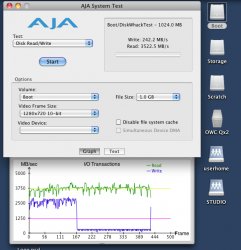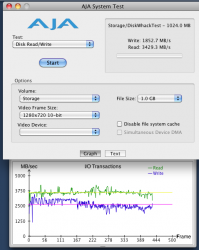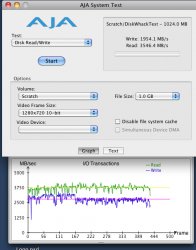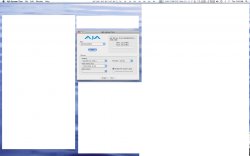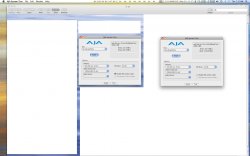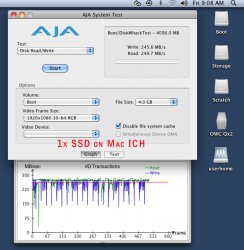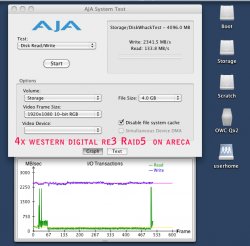Hey,
1. Good news from the Guinea pig I've been away for a while, don't know if this is old news by now but the new Areca raid cards are handling this particular brand of SSDs really nicely, far better than expected in fact. I took a bit of a risk, as at the time of purchase, no information was available regarding the compatibility of the OWC raid edition SSDs and the Areca 1800 raid card.
I've been away for a while, don't know if this is old news by now but the new Areca raid cards are handling this particular brand of SSDs really nicely, far better than expected in fact. I took a bit of a risk, as at the time of purchase, no information was available regarding the compatibility of the OWC raid edition SSDs and the Areca 1800 raid card.
2. The whole setup is posted below, It's one of 5 seats in high end retouching studio. File sizes tend to be quite large. 6Gb, two hundred layer images are not uncommon, hence the choice for more ram slots instead of the faster clock speed of the 6 core. Our initial testing is done, had a whole bunch of photoshop crashes, until disabling open GL, but non since. It's been performing really well 8-10 hours per day for several weeks. We are about build out 3 more.
3. At first I could not understand why the write times, and especially the read times are so far off the charts. I'm thinking this is the the 4GB Cache upgrade (goes right on the card) rockin hard? If I un check "disable file system cache" on the testing software, the write times increase a bit, and the read times go WAY up.
4. Critics will note there is 8Tb working space and 4TB of back up space. The 4x 2TB drives in the internal bays are an after thought to the 1TB drives originally planned. I don't like my guys keeping too much work on the local drives (as opposed the studio server) as it makes global file management difficult, and full drives are slow drives.
5. Thanks to everybody who helped me plot this out on paper, especially a big shout out to Nanofrog and Honomaui. You guys stuck with me till every last question was asked and answered.
Mac Pro 12 Core, 2.93 GHz
• 64GB SDRAM
• ATI Radeon 5870 Graphics Card
• APC Smart-UPS
[..] ------------
RAID Card
• Areca Raid Card, Model ARC-1800 ix-16
• 4GB Cache Upgrade
• Battery BackUp Module
[..] ------------
Lower Optical Bay : Boot, Apps & Scratch
• 1x 240GB OWC Mercury Extreme Pro SSD (OS + Apps)
• Connected To The ICH
• 3x 200GB OWC OWC Mercury Extreme Pro RE SSD (Scratch)
• Connected To The RAID Card (RAID 0)
• MaxConnect 8x - 2.5 inch Disk Drives Mounting Assembly
• Nippon Labs SATA to Molex Power Adapter
[..] ------------
Internal Drives : Bays 1-4 Working Jobs
• 4x 2TB Western Digital RE3 (RAID5)
• MaxConnect SAS/SATA BackPlane Attachment
• Connects the 4 internal HDs to the Areca RAID Card.
[..] ------------
4x 1TB External Back Up
• OWC Mercury Elite-AlPro, Qx2 (RAID 5)
• MaxPower 6G PCIe 2.0 RAID Controller Card
• Remember to run this external BU thru the UPS too.
[..] ------------
Thanks again,
Julian
1. Good news from the Guinea pig
2. The whole setup is posted below, It's one of 5 seats in high end retouching studio. File sizes tend to be quite large. 6Gb, two hundred layer images are not uncommon, hence the choice for more ram slots instead of the faster clock speed of the 6 core. Our initial testing is done, had a whole bunch of photoshop crashes, until disabling open GL, but non since. It's been performing really well 8-10 hours per day for several weeks. We are about build out 3 more.
3. At first I could not understand why the write times, and especially the read times are so far off the charts. I'm thinking this is the the 4GB Cache upgrade (goes right on the card) rockin hard? If I un check "disable file system cache" on the testing software, the write times increase a bit, and the read times go WAY up.
4. Critics will note there is 8Tb working space and 4TB of back up space. The 4x 2TB drives in the internal bays are an after thought to the 1TB drives originally planned. I don't like my guys keeping too much work on the local drives (as opposed the studio server) as it makes global file management difficult, and full drives are slow drives.
5. Thanks to everybody who helped me plot this out on paper, especially a big shout out to Nanofrog and Honomaui. You guys stuck with me till every last question was asked and answered.
Mac Pro 12 Core, 2.93 GHz
• 64GB SDRAM
• ATI Radeon 5870 Graphics Card
• APC Smart-UPS
[..] ------------
RAID Card
• Areca Raid Card, Model ARC-1800 ix-16
• 4GB Cache Upgrade
• Battery BackUp Module
[..] ------------
Lower Optical Bay : Boot, Apps & Scratch
• 1x 240GB OWC Mercury Extreme Pro SSD (OS + Apps)
• Connected To The ICH
• 3x 200GB OWC OWC Mercury Extreme Pro RE SSD (Scratch)
• Connected To The RAID Card (RAID 0)
• MaxConnect 8x - 2.5 inch Disk Drives Mounting Assembly
• Nippon Labs SATA to Molex Power Adapter
[..] ------------
Internal Drives : Bays 1-4 Working Jobs
• 4x 2TB Western Digital RE3 (RAID5)
• MaxConnect SAS/SATA BackPlane Attachment
• Connects the 4 internal HDs to the Areca RAID Card.
[..] ------------
4x 1TB External Back Up
• OWC Mercury Elite-AlPro, Qx2 (RAID 5)
• MaxPower 6G PCIe 2.0 RAID Controller Card
• Remember to run this external BU thru the UPS too.
[..] ------------
Thanks again,
Julian
Attachments
Last edited:


